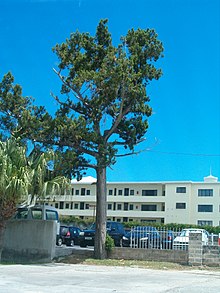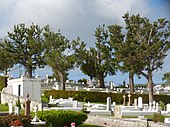
Bermuda is an overseas territory of the United Kingdom in the North Atlantic Ocean. Located off the east coast of the United States, it is situated around 1,770 km (1,100 mi) northeast of Miami, Florida, and 1,350 km (840 mi) south of Halifax, Nova Scotia, west of Portugal, northwest of Brazil, 1,759 km (1,093 mi) north of Havana, Cuba and north-northeast of San Juan, Puerto Rico. The nearest landmass is Cape Hatteras, North Carolina, about 1,030 km (640 mi) west-northwest, followed by Cape Sable Island, Nova Scotia, Canada 1,236 km northward. Although commonly referred to in the singular, the territory consists of approximately 138 islands, with a total area of 57 km2 (22 sq mi).
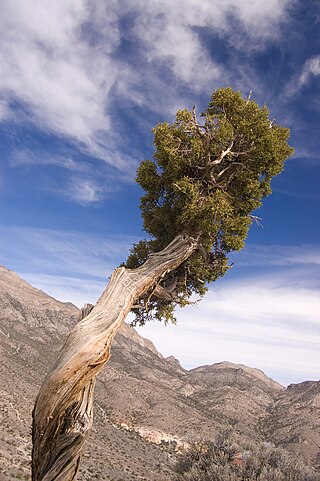
Junipers are coniferous trees and shrubs in the genus Juniperus of the cypress family Cupressaceae. Depending on the taxonomy, between 50 and 67 species of junipers are widely distributed throughout the Northern Hemisphere, from the Arctic, south to tropical Africa, throughout parts of western, central and southern Asia, east to eastern Tibet in the Old World, and in the mountains of Central America. The highest-known juniper forest occurs at an altitude of 4,900 metres (16,100 ft) in southeastern Tibet and the northern Himalayas, creating one of the highest tree lines on earth.
Blight is a specific symptom affecting plants in response to infection by a pathogenic organism.

Juniperus communis, the common juniper, is a species of small tree or shrub in the cypress family Cupressaceae. An evergreen conifer, it has the largest geographical range of any woody plant, with a circumpolar distribution throughout the cool temperate Northern Hemisphere.

Juniperus virginiana, also known as eastern redcedar, red cedar, Virginian juniper, eastern juniper, red juniper, and other local names, is a species of juniper native to eastern North America from southeastern Canada to the Gulf of Mexico and east of the Great Plains. Further west it is replaced by the related Juniperus scopulorum and to the southwest by Juniperus ashei. It is not to be confused with Thuja occidentalis.

Juniperus ashei is a drought-tolerant evergreen tree, native from northeastern Mexico and the south-central United States to southern Missouri. The largest areas are in central Texas, where extensive stands occur. Ashe juniper grows up to 10 metres tall, and over time can reach 15 m (49 ft), and provides erosion control and year-round shade for wildlife and livestock.

Casuarina equisetifolia, commonly known as coastal she-oak, horsetail she-oak, ironwood,beach sheoak, beach casuarina or whistling tree is a species of flowering plant in the family Casuarinaceae and is native to Australia, New Guinea, Southeast Asia and India. It is a small to medium-sized, monoecious tree with scaly or furrowed bark on older specimens, drooping branchlets, the leaves reduced to scales in whorls of 7 or 8, the fruit 10–24 mm (0.39–0.94 in) long containing winged seeds (samaras) 6–8 mm (0.24–0.31 in) long.
Bermuda, Islands of Bermuda, or The Somers Isles is an Atlantic archipelago, British Overseas Territory, and a former part of Virginia.

Casuarina, also known as she-oak, Australian pine and native pine, is a genus of flowering plants in the family Casuarinaceae, and is native to Australia, the Indian subcontinent, Southeast Asia, islands of the western Pacific Ocean, and eastern Africa.
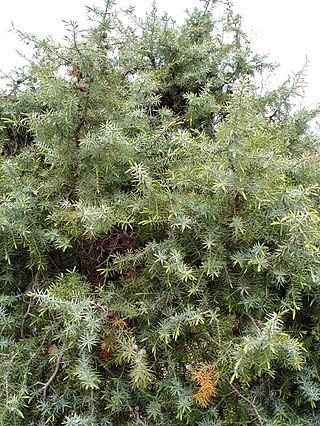
Juniperus oxycedrus, vernacularly called Cade, cade juniper, prickly juniper, prickly cedar, or sharp cedar, is a species of juniper, native across the Mediterranean region, growing on a variety of rocky sites from sea level. The specific epithet oxycedrus means "sharp cedar" and this species may have been the original cedar or cedrus of the ancient Greeks.
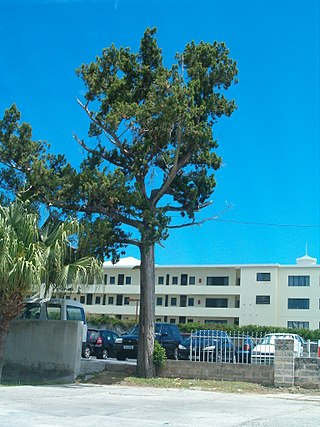
The flora and fauna of Bermuda form part of a unique ecosystem due to Bermuda's isolation from the mainland of North America. The wide range of endemic species and the islands form a distinct ecoregion, the Bermuda subtropical conifer forests.

Juniperus osteosperma is a shrub or small tree native to the southwestern United States.
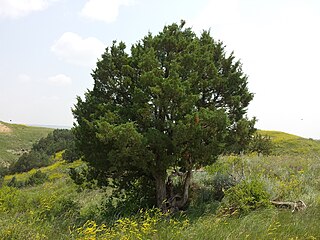
Juniperus scopulorum, the Rocky Mountain juniper, is a species of juniper native to western North America, from southwest Canada to the Great Plains of the United States and small areas of northern Mexico. They are the most widespread of all the New World junipers. They are relatively small trees, occasionally just a large bush or stunted snag. They tend to be found in isolated groves or even as single trees rather than as the dominant tree of a forest. Though they can survive fires, they are vulnerable to them especially when young and this is one of the factors that can limit their spread into grasslands.

Spittal Pond Nature Reserve is the largest wildlife sanctuary in Bermuda, located close to the Atlantic coast of Smith's Parish. Surrounding the third largest pond in Bermuda, Spittal Pond, it covers an area of 60 acres (24 ha). It is one of 13 parks or reserves managed by the Bermuda Department of Conservation Services which protects and conserves environmentally critical areas and habitats. The pond reserve, a wetland site, is one of the seven Ramsar Sites in Bermuda, which was approved on 10 May 1999 for the criteria of its unique characteristics such as its lagoon which is permanently brackish, ecology featuring wet grassland and mangrove forests, seasonal shorebirds, other ver run waterbirds and European eels. It is also home to many types of species mostly including birds.

Juniperus procera is a coniferous tree native to mountainous areas in Africa and the Arabian Peninsula. It is a characteristic tree of the Afromontane flora.

Juniperus brevifolia, the Azores juniper, is a species of juniper, endemic to the Azores, where it occurs at altitudes of 240–800 metres, rarely up to 1,500 m (4,900 ft). It is closely related to Juniperus oxycedrus of the Mediterranean region and Juniperus cedrus of the neighboring Macaronesian islands. It is threatened by habitat loss.

The Bahamian pineyards are a tropical and subtropical coniferous forest ecoregion in the Bahamas and the Turks and Caicos Islands.

Paget Marsh Nature Reserve, also known as Paget Marsh, is an unspoiled marsh, forest, and nature reserve in central Bermuda. It is located next to St. Paul's Church along Middle Road in Paget Parish, to the south of Hamilton Harbour. The 25 acres (10 ha) official reserve is protected by the Bermuda National Trust and Bermuda Audubon Society. It is also a Ramsar wetland of international importance.

Phomopsisblight of juniper is a foliar disease discovered in 1917 caused by the fungal pathogen Phomopsis juniperovora. The fungus infects new growth of juniper trees or shrubs, i.e. the seedlings or young shoots of mature trees. Infection begins with the germination of asexual conidia, borne from pycnidia, on susceptible tissue, the mycelia gradually move inwards down the branch, and into the main stem. Management strategies mainly include removing and destroying diseased tissue and limiting the presence of moisture on plants. Junipers become resistant to infection as they mature and the young yellow shoots turn dark green. Preventive strategies include planting only resistant varieties and spraying new growth with fungicide until plants have matured.
